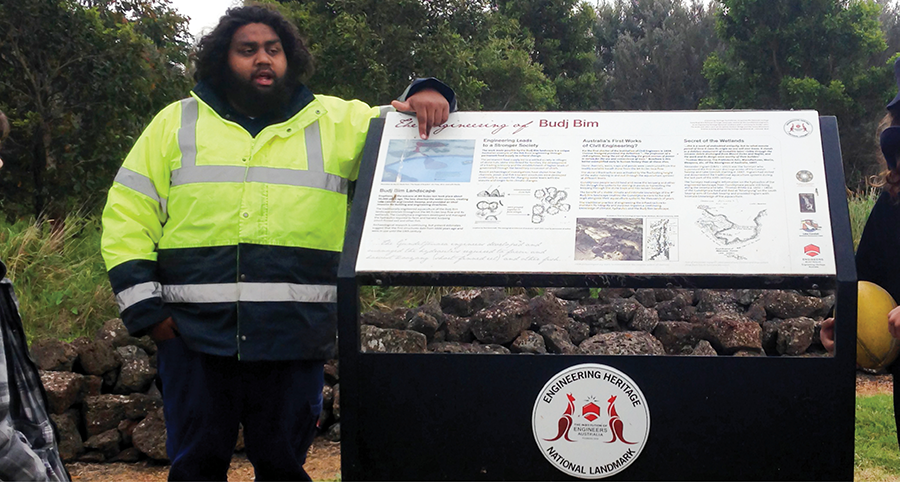Back to VCAA Bulletin No. 50 - July 2019

Braydon Saunders leading a tour of Tyrendarra Indigenous Protected Area
Paying respect to our languages
Australian writer, editor and anthologist Bruce Pascoe once commented, 'We're tempted these days to think of Aboriginal culture as art, dance, music, and theatre. But, really, the crux of it is language. If we're going to revive our culture, we've got to revive our languages.' It's a view shared by the United Nations, which has nominated 2019 as the International Year of Indigenous Languages.
The VCAA has long supported teaching Victorian Aboriginal languages in schools. In 2004, the VCE Indigenous Languages of Victoria: Revival and Reclamation Study Design was accredited and in 2016 the Victorian Curriculum F–10: Victorian Aboriginal Languages was published, replacing an earlier 2009 document. With the support of local Aboriginal communities, 10 schools across Victoria are now teaching eight Victorian Aboriginal Languages.
One of these schools is the Heywood and District Secondary College, part of a small rural community in the south-west of Victoria. The Heywood township has a population of 1300, of which approximately 10 per cent are local Gunditjmara people. The secondary school has been delivering an Aboriginal languages program for several years, in large part due to the initiative and hard work of the school's Curriculum Coordinator, Steph Tashkoff. We asked Steph to tell us more about the journey.
The first step toward a Gunditjmara language program happened when I was studying for my Master of Literacy program with the Melbourne Graduate School of Education in 2011. Gunditjmara woman and linguist Vicki Couzens spoke to us about code-switching and how Koori kids switch between the languages of their home and school. She also explained that when Aboriginal and Islander students are educated in language and culture, they develop stronger sense of self, which leads to greater success at school and in the world beyond school. This resonated with me, as I could see that not all Koori students at Heywood and District Secondary College were continuing to the end of Year 12 at the same rates as their non-Indigenous friends.
The next step happened when there was an opening for a new language program at the school. The Principal at the time, Steve Crossley, responded positively when I proposed the idea of an Aboriginal language program. At that time, there were 30 Koori students at the local primary school. We started talking to representatives of the local Traditional Owners and were able to gain funding to support the employment of an Aboriginal Language tutor within the classroom.
It was at this point that serendipity, or perhaps the brush of Bunjil's wings, played its part. The VCAA was starting up two pilot programs for the reclamation and revival of Aboriginal languages – one for primary school and one for secondary. The project was supported by the Victorian Aboriginal Education Association Incorporated and the Victorian Aboriginal Corporation for Languages with support from liguist Julie Reid. A round table was held between the school and key players from the different state bodies and local organisations, and Traditional Owners' approval was given to the proposed program. Our first Aboriginal language tutor, Gunditjmara woman Yaraan Bundle, was employed and the program was launched at the school in 2012.
Since then, every student in Years 7 and 8 has studied a program that includes topics such as 'Aboriginal history', 'Family and kinship', 'Eels', 'Aboriginal people and the environment', 'Aboriginal servicemen and women' and 'Aboriginal art and story'. Each year, our students give an acknowledgement of Country in Dhauwurd Wurrung (our local dialect) at the community celebration held by the Glenelg Shire to mark the end of Reconciliation Week. In 2013, the first year this happened, the student who gave the acknowledgement was red-haired James Gray of Year 7. One of the local Gunditjmara elders was, at first, stunned to hear her language spoken by a non-Indigenous boy. She later said her heart was warmed to know that her language was being shared and valued in this way.
We have passed our education units to Winda-Mara's Budj Bim Rangers, who take tours out on Country. A highlight last year was taking our Year 8 Aboriginal Language and Culture class to the Tyrendarra Indigenous Protected Area. The tour was led by former student, Braydon Saunders (pictured on page 1), who had participated in the program when he was in Years 7 and 8. Braydon interspersed his discussion of cultural practices and history with key terms in Dhauwurd Wurrung.
We are a small school but our respect for the cultural heritage and knowledge of the local First Nations people is great. Our school has wonderful racial harmony and we promote the cultural safety of Koori students and their families. We continue to strive towards all our students completing their education. This year, all of our Year 10 Koori students intend to complete Year 12.
The Aboriginal Language and Culture program recognises that everyone who lives in Heywood has a connection to Gunditjmara Country. It is our responsibility as a learning community to develop our understanding of this Country and to celebrate the amazing history and heritage that we are privileged to learn about. When I see Year 7 students avidly learning about the 1967 Referendum or enthusiastically developing language learning resources to share, I feel that we are paying respect to the old people who have been before us and paving the way to a more positive future for these young people.